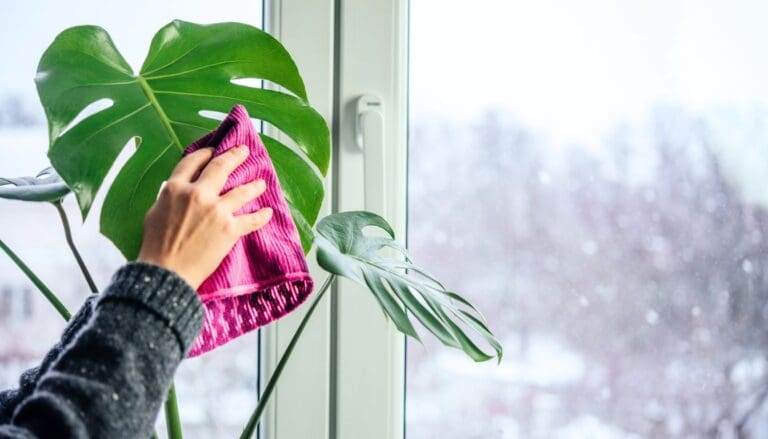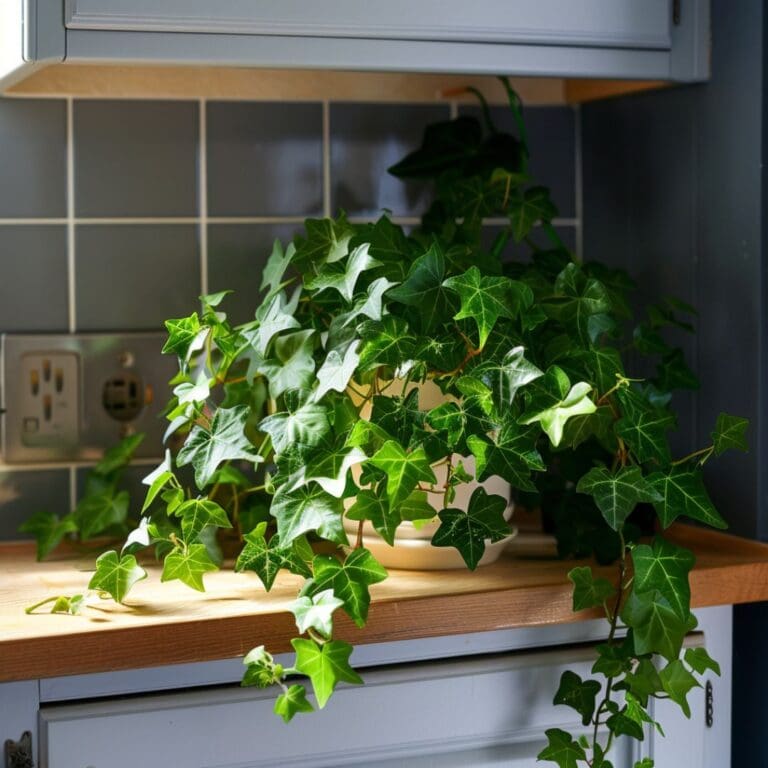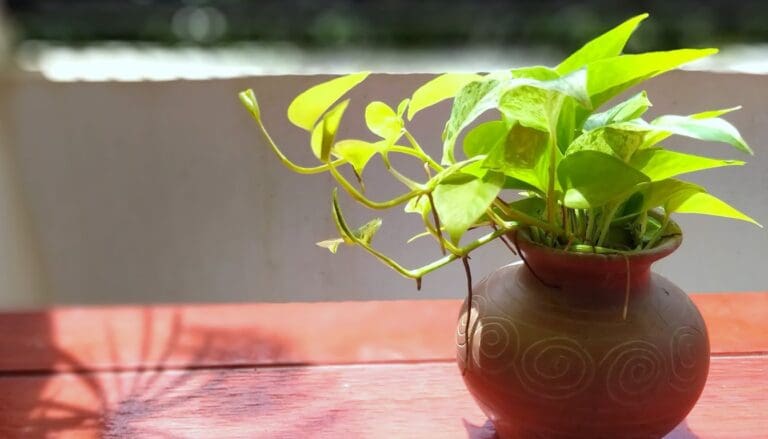Why Are My String Of Pearls Turning Black? (Causes+How To Fix)
The string of pearls has plump green leaves that are great to look at, but if you notice black leaves on the plant, it means that there I some issue with your plant.
Black leaves are not the initial signs of any problem, but it indicates that the plant has been suffering from a persistent problem. Usually, the leaves turn yellow or brown and then turn black.
Lighting and watering issues, low humidity, bacterial infection, and stress are some reasons that can lead to black leaves on the string of pearls. If you want to save your plant from further problems, you have to identify the cause of black leaves and take appropriate actions to save your plant.
We have jotted down some causes and how to fix them in this article to help you treat black leaves on your string of pearls.

Please note: Simplify Plants is reader-supported. Some links in the post are affiliate links and I get a commission from purchases made through links in the post.
What causes black leaves on string of pearls?
When you ignore a requirement or a problem in your plant for a long period, you might notice the leaves of the plant turns black.
Many reasons are responsible for causing the leaves to turn black in the string of pearls plants. The first things you need to check are the watering and the lighting and try to fix if there is an issue.
Lighting Issues

Both low and excess light can lead to black leaves on your plant. If you expose your string of pearls to direct sunlight, it will suffer due to the harsh light, and eventually, the leaves will turn black.
The string of pearls can’t tolerate intense sunlight. It can stress the plant and scorch the leaves and make them brown or black over time.
The string of pearls can handle low-light conditions, but keeping them in low light for a long time will bring in problems. The plant will fail to photosynthesize due to a lack of light and low energy.
When the plant becomes weak, it affects all the parts, including the leaves. Due to insufficient energy, the plant loses its color and becomes black.
Improper Watering
Improper watering can cause leaves to turn black in the string of pearls. It can happen both in the cases of overwatering and underwatering.
When you overwater the string of pearls, the root rots, and the tips of its pearls or leaves turn black. When there is root rot, the roots fail to function correctly and cannot absorb water or nutrients.
The plant suffers due to nutrition deficiency, and therefore, the leaves turn yellow or black. If not treated on time, the plant might give up on you.
On the other hand, underwatering can make the string of pearls dehydrated and dull. Due to insufficient water, the plant will start becoming dry, and the leaves will turn brown and black.
It is easier to treat an underwatered string of pearls than an overwatered one, but if you keep neglecting your plant’s water requirements, even an underwatered plant will end up dying.
Temperature Changes

The string of pearls usually does well in average room temperatures, but a sudden rise or fall in the temperature levels will shock the plant, making it weak, leading to black leaves.
The leaves of the string of pearls shrivel due to the shock and turn brown. In the later stages, the leaves become black.
If you expose your string of pearls to frost or cold drafts during the winter, it will get stressed. And if you place it outdoors during winter, it might get severe shock and might not recover.
Relocating the plant to a different location can also stress the plant because of the change in the temperature. Due to this stress, the leaves will turn brown and then black.
When you keep ignoring the signs and don’t do anything about your plant’s issues, the leaves turn black and fall off.
Improper Fertilization
If you don’t keep a check on fertilizing the plant, it can either be too much or too little for your plant, and both can cause problems.
Many plant owners fertilize their plants more than required as they think fertilizing more will bring faster growth in the plants. However, that is not the case, and instead, the plant suffers.
If you add too much fertilizer to the plant, it will burn the roots and make the tips of the leaves turn black. Eventually, the whole leaf will turn black.
Inadequate fertilization can also damage the plant. When you don’t give enough fertilizer to your plant, it will have slow growth.
The plant will lack nutrition due to a lack of fertilizer. The plant will become weak as the soil alone will not be able to provide as much nutrition.
Pest Infestation

Pests can make the leaves of your string of pearls turn black. Some common ones that you might notice on your string of pearls are aphids, spider mites, whiteflies, etc.
The pests are tiny creatures that can go unnoticed for a long time. These pests are hard to notice with naked eyes.
The pests suck the sap of the string of pearls which makes the plant lose all the nutrition. In addition, the pests damage the plant’s root system, due to which the leaves get discolored or turn black.
Bacterial and Fungal Infections
Overwatering, low light conditions, poor ventilation, and many other reasons cause bacterial or fungal infections in the string of pearls.
If there is a bacterial infection, the leaves have yellow spots on the undersides. Without treatment, the leaves will turn black. The leaves shrivel and turn black due to bacterial infections.
In fungal infections, you will see black spots on the leaves that will keep increasing with time, and eventually, the whole leaf will turn black.
If you overwater or mist your string of pearls, the water will sit on the leaves, and that will cause black spots on them.
Damaged or Infected New Plant

If you have bought a new plant home, chances might be that the plant has undergone some damage while transportation or was infected already.
If your string of pearls was already infected and was not treated on time, you will not be able to cure it even if you provide enough light, sufficient water, proper temperatures, and all the other things that the plant requires.
Such plants can even spread the infection to other plants, so you should be careful about that. In addition, the plant might eventually die.
How to fix black leaves on string of pearls?
If your string of pearls has black leaves, you need to find out what’s wrong with it. Once you’ve found out what’s wrong, you need to fix it.
The string of pearls requires enough light, proper watering, adequate fertilizing, and the right weather conditions to thrive.
The leaves that have turned black don’t have the chance to become healthy again. So you need to prune them and save the other leaves so that they don’t turn black.
We have discussed the issues already, and now we’ll understand how to treat the problems.
Fix the lighting

The string of pearls doesn’t enjoy direct sunlight. They can tolerate the morning sunlight for few hours, but the afternoon sun gets too harsh for them.
The string of pearls becomes dry when placed under direct sunlight, and the leaves become yellow and then black.
If you give your string of pearls six to eight hours of indirect light, the plant will thrive. Therefore, you should avoid keeping it under direct sunlight.
Don’t consider moving your string of pearls to a spot that doesn’t have enough light. Low light can be harmful as the leaves will not get enough energy due to lack of light, and the leaves will get discolored.
If you are moving the string of pearls into a different spot to save it from direct sun or moving it away from low light, doing it all of a sudden can shock the plant.
Let the plant adjust by moving the plant gradually. Start by keeping it at the new spot for some time every day. Increase the time gradually before you finally move the plant.
Also read: How Much Light Does String Of Pearls Need?
Watering

Water the string of pearls after checking the soil and making sure that it is dry. To check the moisture, stick your finger into the soil or use a moisture meter.
You can follow a watering regime to avoid keeping your plant thirsty but never water without checking the soil.
Ensure that your string of pearls has a sound drainage system. Use the right-sized pot with drainage holes and keep checking them to ensure that the holes don’t get blocked.
Water the plant thoroughly and check if the drainage holes let the excess water flow out of the system.
Reduce the watering during winter as the plant doesn’t grow actively during this time and doesn’t require as much water.
Also read: How Often Should You Water String Of Pearls?
Adjust the Temperature
The string of pearls, like other houseplants, enjoys staying in a controlled environment where the temperature remains average.
However, it can’t tolerate sudden changes, freezing temperatures, or heat waves.
The string of pearls thrives in temperatures above 70°F, but an average temperature of 50°F-60°F works well.
If the temperatures drop below the average levels, that becomes harmful for your plant.
Keep your string of pearls away from cold drafts and frost during the winter months. If your string of pearls is placed outside, bring it inside to save it from the freezing temperatures.
Avoid placing the plant near heating systems like radiators, furnaces, or even fireplaces, as the heat can burn the leaves. You can put it a few feet away so that it doesn’t receive excess heat.
Also read: Where Should I Keep My String Of Pearls Plant?
Fertilizing

Fertilizing is an excellent way of keeping the string of pearls healthy. Fertilizing helps to add nutrients to the soil that the plant absorbs.
Overfertilizing can have a salt build-up in the soil. So, if you have an overfertilized string of pearls, water it thoroughly to let the salt drain out along with the water through the drainage holes.
The string of pearls requires light doses, so using a well-balanced liquid fertilizer will give good results.
Avoid fertilizing more than once or twice during the growing season. And don’t fertilize during the winter months.
Always water the plant before adding the fertilizer so that it gets spread evenly in the soil.
Also read: Should You Fertilize String Of Pearls?
Get rid of pests
If your plant has a pest infestation, keep it away from the other plants of the house to prevent any spread.
Try to use an organic way of treating pests as chemical pesticides often contain harmful chemicals for the plants.
One great way of getting rid of pests is by using neem oil. Use a neem solution and spray it on the plant or dip a cotton ball in diluted neem oil and dab it on the infested areas.
Keep repeating this for two weeks to eliminate all pests.
Neem oil can not only eliminate but also prevent pests from infecting your string of pearls. You can apply this every month even if your plant is not infested to keep the pests at bay.
If you don’t have neem oil, there are other alternatives available in your home. Use rubbing alcohol to kill the pests or use soapy water that is safe for the plants.
Also read: Do String Of Pearls Attract Bugs? How to deal with them?
Treating Bacterial or Fungal Infections
If your plant is grouped with other plants, remove it and relocate it to prevent further spread.
Water the plant and keep it under indirect light to let it get dry.
Use sterilized pruners to prune the damaged parts and avoid pruning when the plant is wet.
Spray fungicides on the plant to treat the infections.
Fix the infected plant or cuttings
You may have bought an already infected plant, which is hard to treat and infects other plants around it.
If you have bought a new string of pearls and notice problems, don’t group it with other plants and keep it isolated. Spray fungicide and pesticide to treat the infections.
In case of cuttings, always make sure that the cutting of the plant is healthy. Always use sterilized pruners to make the cuttings.
Ref: Wikipedia, Missouri Botanical Garden, University of Wisconsin.
Recommended Garden Supplies
| Product Image | Our Recommended Gardening Supplies | Check Offers! |
|---|---|---|
Top Top
Top
Top
Top
Top
Top
Top
Top | rePotme Houseplant and Tropical Classic Potting Soil Mix | Check Offer On Amazon |
 Top
Top
Top
Top
Top
Top
Top
Top | Espoma Organic Indoor Plant Food | Check Offer On Amazon |
 Top
Top
Top
Top
Top
Top
Top
Top | GooingTop LED Grow Light 6000K Full Spectrum Clip Plant Growing Lamp | Check Offer On Amazon |
 Top
Top
Top
Top
Top
Top
Top
Top | Soil Moisture Meter | Check Offer On Amazon |
 Top
Top
Top
Top
Top
Top
Top
Top | Govee Hygrometer Thermometer, Bluetooth Enabled! | Check Offer On Amazon |
 Top
Top | LEVOIT Humidifiers for Large Room(Best For Plants) | Check Offer On Amazon |
 Top
Top
Top
Top
Top
Top
Top
Top | Upgraded DIY Automatic Drip Irrigation Kit, 15 Potted Houseplants Support | Check Offer On Amazon |
 Top
Top
Top
Top
Top
Top
Top
Top | Stainless Steel Heavy Duty Gardening Tool Set | Check Offer On Amazon |
 Top
Top
Top
Top
Top
Top
Top
Top | Bonide Insecticidal Soap | Check Offer On Amazon |
 Top
Top
Top
Top
Top
Top
Top
Top | Bonide 32 oz Spray Neem Oil for Organic Gardening | Check Offer On Amazon |
 Top
Top
Top
Top
Top
Top
Top
Top | Garden Safe Fungicide | Check Offer On Amazon |







